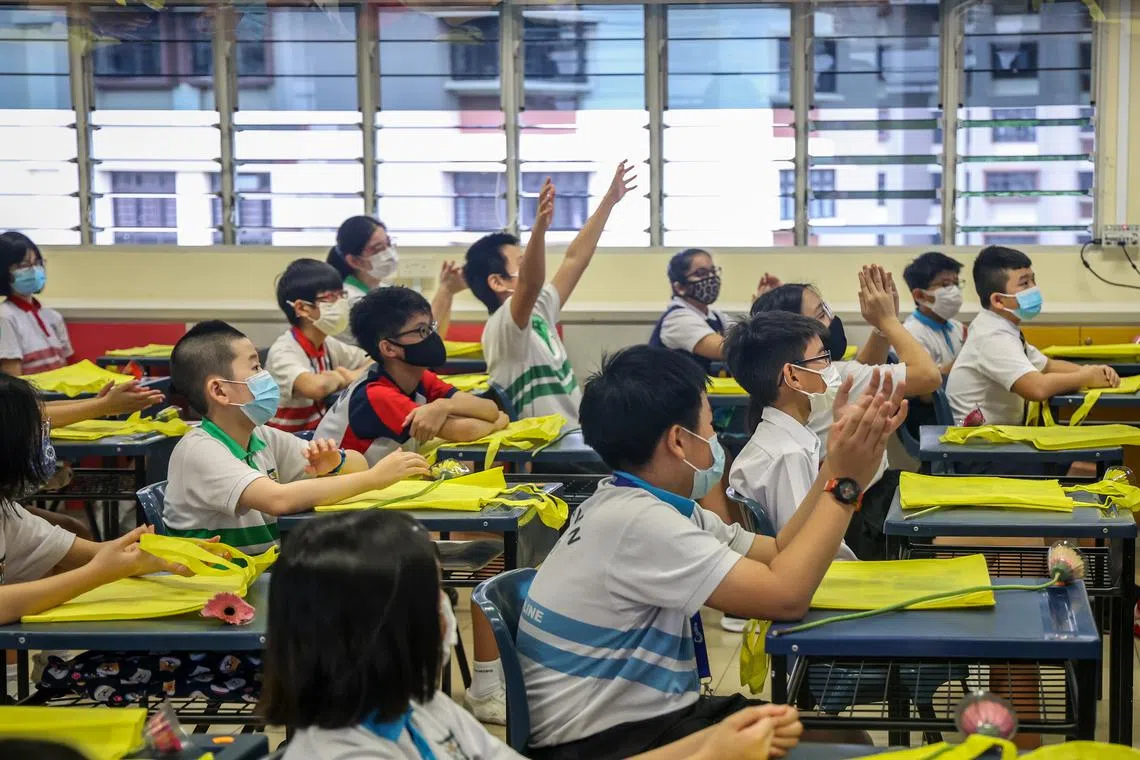Applications for direct admission to secondary schools rising steadily: MOE
Sign up now: Get tips on how to help your child succeed

There were 31,800 Direct School Admission applications from 12,200 pupils this year, with 3,900 eventually receiving offers.
PHOTO: LIANHE ZAOBAO
Follow topic:
SINGAPORE - The number of primary school pupils applying to secondary schools through direct admissions continues to rise steadily, said the Ministry of Education’s (MOE) director of schools.
There were 31,800 applications from 12,200 pupils in 2022, with 3,900 eventually receiving offers, Mrs Tan Chen Kee said on Saturday at The Straits Times Smart Parenting post-PSLE webinar.
This is up slightly from 2021, which saw 31,400 applications from 12,100 pupils, of whom 3,800 received offers, she added.
Mrs Tan, who is also a deputy director-general at MOE, said: “We see it (application numbers) creeping up, which is not a bad thing because it’s part of what MOE has been doing in terms of encouraging schools to offer direct school admissions across the education landscape, and also, in the primary schools, to encourage parents to consider it.”
Direct School Admission is a programme that allows primary school pupils to apply to secondary schools before the Primary School Leaving Examination (PSLE) on the merit of their unique abilities in areas such as sports and creative writing, as well as academic subjects like science and the humanities.
Mrs Tan was speaking to ST’s senior education correspondent, Ms Sandra Davie, at the webinar aimed at explaining to parents the new PSLE scoring system,
The session also covered topics such as full subject-based banding, which will be offered by more secondary schools in 2023.
The new PSLE scoring system – intended to reduce fine differentiations in pupils’ grades – now scores pupils in absolute bands of 1 to 8 for each subject. Under the previous system, pupils received a T-score that was calculated based on their peers’ results.
Mrs Tan addressed parents’ concerns about how the new system affects pupils’ results.
She said that while the scoring and posting system has changed, the exams have not, and pupils’ performances have remained consistent.
She said: “If you look at the results and the allocation of pupils to the different courses, that has also remained consistent over the past number of years... Schools that saw a little bit of fluctuation only saw a fluctuation of one point. The percentage of pupils that have been posted to one of their first three choices of school also remained consistent and stable at about 80 per cent.”
Mrs Tan added that many more pupils received the same PSLE scores.
Under the new system, a pupil can get only 29 possible scores.
She said: “What this meant for the pupils last year was that they had a greater variety of choices. This also meant that when they got their PSLE results, it wasn’t an exercise in comparison.”
Mrs Tan also tackled the persistent idea among parents that bell-curving is used to determine scores. Bell-curving is the statistical practice of moderating grades after exams are taken to ensure that they fall in a specific distribution.
She said: “The infamous bell curve, we must ring the death knell for the bell curve. Perhaps let me categorically state that the bell curve is not used for all national examinations, including the PSLE.”
At the webinar, Mrs Tan also advised parents on how to pick a school for their children under the new scoring and posting systems.
Under 2021’s changes, a pupil’s order of choices for schools is used as a tie-breaker between pupils with the same score.
She said: “It’s a broader-base scoring system, and the reason we made those changes is really to shift parents and pupils away from that infatuation with their top choice.
“I want to encourage parents not to just put all your eggs into that top-choice basket, because if we’re looking at schools that are now bunching in terms of their cut-off points, there are a lot more choices available.”
The webinar was followed by three break-out sessions with the principals of Singapore Chinese Girls’ School, St Joseph’s Institution, St Andrew’s Secondary School, Temasek Secondary School, Bowen Secondary School and Swiss Cottage Secondary School.
The principals discussed school choices and took questions on topics such as how to tell if a child is suitable for the Integrated Programme, a six-year through-train programme some schools offer where students skip the O-level exams.


